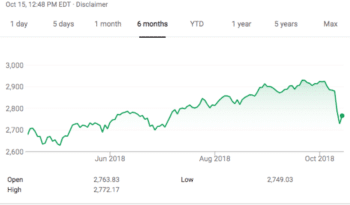702-660-7000
702-660-7000

Ouch! The market had a hiccup last week giving up nearly all the gains it attained over the summer.
Now, maybe you don’t have enough in the market to worry about that hiccup or maybe you have enough invested that you now feel you need to hold on until this market recovers and you regain your losses. But in reality, with many Americans retiring (10,000 a day according to AARP[i]), this market hiccup meant 20,000 people retired last Thursday and Friday with less money in their accounts than they had planned on having.
The point is, these sudden but not infrequent market dips, eliminate the market as being the safest place for you to store your hard-earned money. One sudden move like last week’s DOW correction of 1,300 points and you quickly kiss goodbye to a portion of what you’ve already earned.
Think about this:
Added to this is the fact that volatility, the tendency of the market to suddenly rise or fall sharply, increases as the market declines and decreases as the market rises. Therefore, your risk rises as volatility increases and returns decrease.[iv]
Of course, Participating Whole Life Insurance (PWLI) isn’t subject to market volatility. Unlike Universal Life Insurance policies, including Indexed Universal Life and Variable Universal Life, PWLI is a contract that guarantees your gains! And that means you don’t have to worry about how the market is performing today, tomorrow or for the rest of your life because you have a contract that guarantees you will have a specific amount of gains in your policy in a specific amount of years and that those gains will continue to grow and will be there for you to keep or use as long as you live.
On top of that you also have the right to participate in the profits of the insurance company that issued your PWLI. This participation is classified as a return of premiums paid and is therefore not a taxable event for you. And just like your guaranteed gains mentioned in the previous paragraph, once these dividends are paid to you by the insurance company, you won’t be forced to give them up like you would when the market dips like it did this past week. In fact, you won’t ever be required to give up these gains as long as you own your PWLI. And that means you can enjoy the benefits of sustained earnings working for you over a much longer period of time than traditional market investments, but without the anxiety of anticipating the next dip.
Many people say that PWLI can’t keep up with the gains that you can make in the market. Perhaps they are right. But then again, the gains made in PWLI aren’t subject to market volatility and everyone knows that “A bird in the hand is worth two in the bush.” And when you assume the risk of the market you become subject to its whims and whams with no guarantees.
Of course, PWLI gains are not taxed as income, nor will they face capital gains taxes as market investments must. Gains in PWLI are not subject to management fees and will not trigger a tax on your future Social Security Benefits like most investment gains will do. That being said, it is also nice to know that PWLI will provide a greater legacy for every dollar you spend due to the multiplier effect that takes place for every dollar you pay in premium. That multiplier effect simply doesn’t happen with traditional investments.
Obviously, PWLI does all this at the same time it is providing your guaranteed gains and dividend participation.
Fortunately, in these volatile times you still have the choice of deciding if you want sustainability or if you’d rather assume the high risk associated with seeking greater gains. PWLI is the only place where you can safely secure your money so that you have guaranteed growth and liability protection while you are completely insulated from all market dips, taxes and fees that destroy the gains that can be achieved in other investments. Safe, steady, sustainable growth is not only desirable, it is a must in these volatile times, if you want to protect your gains.
[i] https://www.fool.com/retirement/2017/07/29/9-baby-boomer-statistics-that-will-blow-you-away.aspx
[ii] https://www.cnbc.com/2018/10/11/us-markets-focus-on-wall-street-rout-as-it-batters-global-markets.html
[iii] https://www.thebalance.com/u-s-inflation-rate-history-by-year-and-forecast-3306093
[iv] https://www.investopedia.com/articles/financial-theory/08/volatility.asp